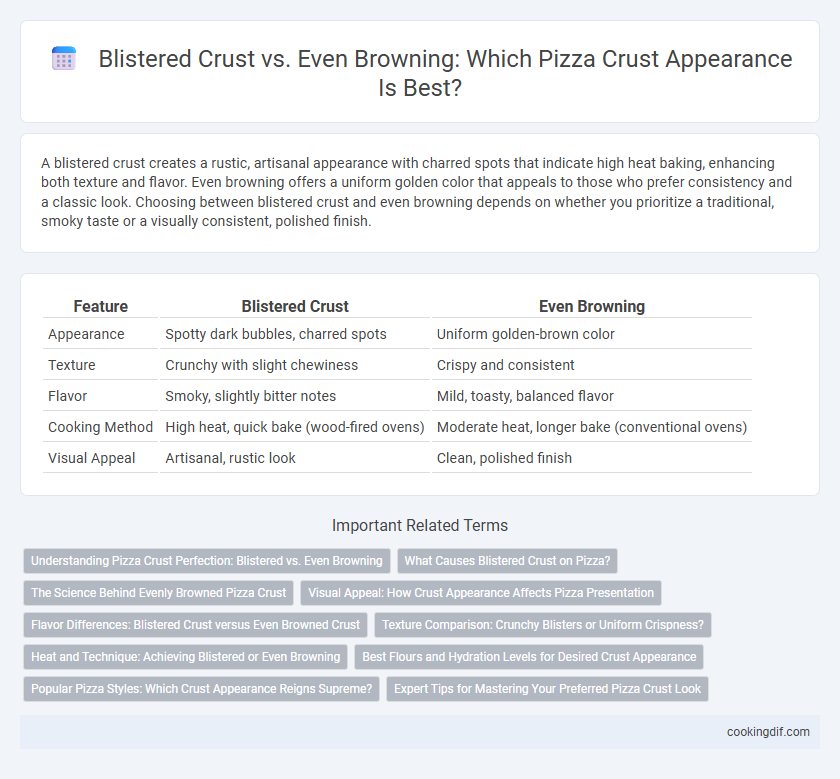A blistered crust creates a rustic, artisanal appearance with charred spots that indicate high heat baking, enhancing both texture and flavor. Even browning offers a uniform golden color that appeals to those who prefer consistency and a classic look. Choosing between blistered crust and even browning depends on whether you prioritize a traditional, smoky taste or a visually consistent, polished finish.
Table of Comparison
| Feature | Blistered Crust | Even Browning |
|---|---|---|
| Appearance | Spotty dark bubbles, charred spots | Uniform golden-brown color |
| Texture | Crunchy with slight chewiness | Crispy and consistent |
| Flavor | Smoky, slightly bitter notes | Mild, toasty, balanced flavor |
| Cooking Method | High heat, quick bake (wood-fired ovens) | Moderate heat, longer bake (conventional ovens) |
| Visual Appeal | Artisanal, rustic look | Clean, polished finish |
Understanding Pizza Crust Perfection: Blistered vs. Even Browning
Blistered crust features charred bubbles and a smoky flavor from high heat cooking, creating a visually dynamic, artisanal appearance prized in Neapolitan-style pizzas. Even browning results in a uniform golden crust, emphasizing crispness and a balanced Maillard reaction that appeals to those who prefer consistent texture and color. Both methods impact mouthfeel and taste, with blistered crusts offering complexity and even browning delivering a reliable, approachable finish.
What Causes Blistered Crust on Pizza?
Blistered crust on pizza results from high-temperature baking, typically above 800degF, which causes rapid gas expansion in the dough's surface bubbles, creating charred spots and a distinctive texture. The presence of steam and quick heat exposure forms uneven caramelization and Maillard reaction, leading to the characteristic blisters. In contrast, even browning occurs at moderate temperatures with slower baking times, producing a uniform crust color without pronounced bubbly spots.
The Science Behind Evenly Browned Pizza Crust
Evenly browned pizza crust results from Maillard reactions and caramelization occurring uniformly across the dough surface, requiring consistent heat distribution and optimal moisture levels. Blistered crust forms when localized high heat causes small, dark bubbles to rapidly char, creating distinctive spots while leaving other areas lighter. Controlling oven temperature and airflow enhances even browning by promoting steady heat transfer and preventing hotspots that lead to blistering.
Visual Appeal: How Crust Appearance Affects Pizza Presentation
Blistered crusts create a rustic, artisanal look with charred spots that highlight high-heat cooking, enhancing the pizza's visual texture and appeal. Even browning offers a consistent golden hue that signals uniform cooking, appealing to those who prefer a polished and classic appearance. The choice between blistered crust and even browning directly influences the perceived quality and style of the pizza, impacting customer expectations and satisfaction.
Flavor Differences: Blistered Crust versus Even Browned Crust
Blistered crust develops intense, smoky flavors and a slightly charred texture due to high-heat exposure, enhancing the overall depth and complexity of the pizza. Even browning produces a uniform, caramelized crust with a mild sweetness and crispness that highlights a balanced, less aggressive flavor profile. Each method impacts the eating experience by emphasizing either bold, rustic notes or a consistent, subtle taste.
Texture Comparison: Crunchy Blisters or Uniform Crispness?
Blistered crusts feature bubbles that create a crunchy texture with varied crispness, adding depth and charred flavor spots to each bite. In contrast, even browning produces a uniform crispness, delivering a consistent crunch throughout the crust without textural surprises. Texture preference hinges on whether one values the rustic crunch of blistered bubbles or the steady crispness of an evenly browned crust.
Heat and Technique: Achieving Blistered or Even Browning
High-temperature baking between 700degF and 900degF using a pizza stone or steel promotes blistered crust by causing rapid gas expansion and charring spots. Even browning requires moderate heat around 450degF to 500degF with controlled airflow and rotating the pizza to distribute heat uniformly across the dough's surface. Mastering heat intensity and baking duration precisely influences crust texture, appearance, and flavor development.
Best Flours and Hydration Levels for Desired Crust Appearance
Blistered crusts benefit from high-protein bread flours and higher hydration levels around 70-75%, creating a more open crumb and charred spots under intense heat. Even browning requires all-purpose or 00 flours with moderate hydration near 60-65%, promoting a uniform golden crust without excessive blistering. Adjusting flour type and hydration directly influences crust texture and visual appeal, optimizing the pizza baking outcome.
Popular Pizza Styles: Which Crust Appearance Reigns Supreme?
Blistered crust, characterized by its charred bubbles and smoky flavor, is a hallmark of Neapolitan-style pizza, providing a rustic and artisanal appearance that pizza enthusiasts often seek. Even browning, common in New York-style and Sicilian pizzas, offers a uniform golden crust that emphasizes crispness and structural integrity. Both crust appearances cater to distinct textures and visual appeals, making the preference largely dependent on popular regional styles and individual taste.
Expert Tips for Mastering Your Preferred Pizza Crust Look
Achieving a blistered crust requires high heat and quick baking, with temperatures around 900degF to create characteristic charred bubbles that add a smoky flavor. Even browning relies on moderate oven heat and consistent airflow to promote uniform caramelization without burning, often achieved at 450degF to 500degF. Expert tips include using a pizza stone or steel to maintain stable heat and adjusting oven rack position to control crust exposure for your preferred crust aesthetics.
Blistered crust vs Even browning for crust appearance Infographic

 cookingdif.com
cookingdif.com